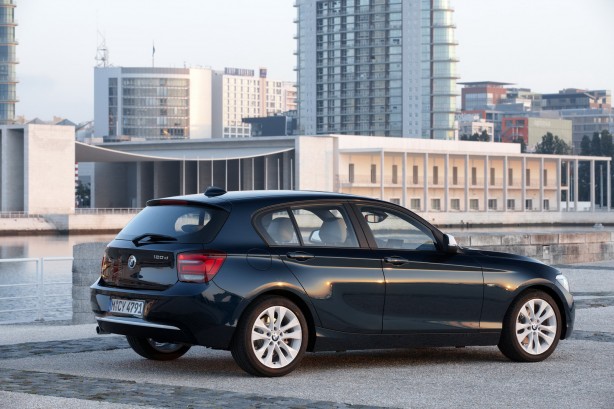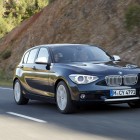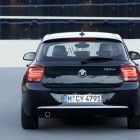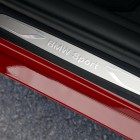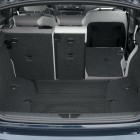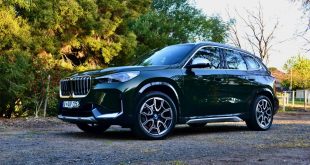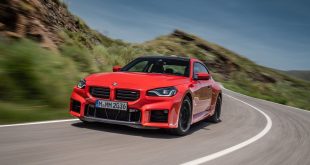BMW has released a raft of photos of the new 1-Series Hatchback. Due to go on sale next year, this will be the last rear-wheel drive 1-Series. Already, the new generation will have two separate drive format, with a slightly smaller and lighter front-wheel drive model being sold alongside this rear-drive baby.
The new 1-Series Hatchback is slightly larger than the outgoing model, but retains the same proportion. A new generation 1.6-litre turbocharged engines with up to 127kW will also be making their debut.
The car will launch as a five-door hatchback but the range will eventually expand to include a three-door hatch, followed by the coupé and cabriolet. The rumour mills are also spinning that a longer and more spacious GT version similar to the 5-Series GT will join the line up later.
Codenamed F20, the 2nd generation 1-Series is built on the same architecture as the upcoming F30 3-Series. The five-door hatch is 85mm longer than its predecessor, at 4,324mm, while the wheelbase has grown by 30mm to 2,690mm. Overall width has also increased by 17mm to 1,765mm to accommodate a 51mm wider track at the front, and 72mm at the back. Height remains unchanged at 1,421mm. The increase in dimensions translates to more rear legroom, with passengers getting an extra 21mm. Boot space has also increased by 30 litres to 360 litres.
Styled under the direction of BMW’s Chief Designer, Adrian van Hooydonk, the car is an evolution of the outgoing model, with an unmistakably 1-Series silhouette. There are however, styling traits that common across BMW’s current line-up, like the shoulder line that cuts across the door handles. The saggy mid-section of the first generation 1-Series has thankfully been put to rest. The front is dominated by a pair of large headlamps and the Bavarian company’s enlarged kidney grilles. For the first time on a BMW, the direction indicators are now housed in the wing mirrors. The rear retains much of the current generation’s look except for the slightly more stylish tail-lamps.
Current owners of 1-Series will feel right at home in the new interior. It’s again very much an evolution of the current theme, aside from the larger centre console with fresh switchgear and new steering wheel design. BMW claims the new car has higher-grade materials and more attention to detail.
Unlike the car’s design, the revolution happens under the bonnet as BMW introduced its smaller capacity, turbocharged four-cylinder petrol engine. The 1.6-litre unit with TwinPower Turbo and direct injection will be available in two states of tune, with an output of 101kW and 220Nm in the 116i and 127kW and 250Nm in the 118i.
There is also a redesigned 2.0-litre turbocharged four-cylinder diesel engine in three states of tune. In the 116d, it delivers 84kW. In the 118d, it delivers 107kW, while in the 120d it delivers 137kW. BMW also confirmed a 116d EfficientDynamics edition with 84kW from a 1.6-litre diesel engine and additional fuel-saving technologies will join the line-up. The ultra-efficient engine will blow out only 99g/km of CO2 from the tail-pipes.
A 2.0-litre turbocharged petrol with around 179kW of power will find its way into the 128i eventually, replacing the current 130i that comes with a 3.0-litre straight-six.
A 6-speed manual gearbox is standard on all models. The current 6-speed auto will be replaced with a new 8-speed unit.
Model versions:
BMW 118i: Four-cylinder in-line petrol engine with
BMW TwinPower Turbo technology package, consisting of twin-scroll turbocharger, High Precision Injection, VALVETRONIC and Double-VANOS variable valve control,
- Capacity: 1, 598 cc, output: 125 kW/170 hp at 4,800 rpm,
- Maximum torque: 250 Nm at 1,500 – 4,500 rpm,
- Acceleration 0 – 100 km/h (62mph): 7.4 seconds,
- Maximum speed: 225 km/h – 140mph
- Combined-cycle fuel consumption*: 5.8 – 5.9 litres/100 kilometres,
- CO2 emissions*: 134 – 137 g/km, emissions standard: EU5.
BMW 116i: Four-cylinder in-line petrol engine with
BMW TwinPower Turbo technology package, consisting of twin-scroll turbocharger, High Precision Injection, VALVETRONIC and Double-VANOS variable valve control,
- Capacity: 1,598 cc, output: 100 kW/136 hp at 4, 400 rpm,
- Maximum torque: 220 Nm at 1,350 – 4, 300 rpm,
- Acceleration 0 – 100 km/h (62mph): 8.5 seconds,
- Maximum speed: 210 km/h -130mph,
- Combined-cycle fuel consumption*: 5.5 – 5.7 litres/100 kilometres,
- CO2 emissions*: 129 – 132 g/km, emissions standard: EU5.
BMW 120d: Four-cylinder in-line diesel engine with
BMW TwinPower Turbo technology package, consisting of variable-geometry turbocharger, common-rail magnetic-valve direct injection
(max. injection pressure: 1,800 bar),
- Capacity: 1,955 cc, output: 135 kW/184 hp at 4, 000 rpm,
- Maximum torque: 380 Nm at 1,750 – 2, 750 rpm,
- Acceleration 0 – 100 km/h (62mph): 7.2 seconds,
- Maximum speed: 228 km/h – 142mph,
- Combined-cycle fuel consumption*: 4.5 – 4.6 litres/100 kilometres,
- CO2 emissions*: 119 – 122 g/km, emissions standard: EU5.
BMW 118d: Four-cylinder in-line diesel engine with
BMW TwinPower Turbo technology package, consisting of variable-geometry turbocharger, common-rail, magnetic-valve direct injection (max. injection pressure: 1,600 bar),
- Capacity: 1,955 cc, output: 105 kW/143 hp at 4,000 rpm,
- Max. torque: 320 Nm at 1,750 – 2, 500 rpm,
- Acceleration 0 – 100 km/h (62mph): 8.9 seconds,
- Maximum speed: 212 km/h – 132mph
- Combined-cycle fuel consumption*: 4.4 – 4.5 litres/100 kilometres,
- CO2 emissions*: 115 – 118 g/km, emissions standard: EU5.
BMW 116d: Four-cylinder in-line diesel engine with
BMW TwinPower Turbo technology package, consisting of variable-geometry turbocharger with common-rail, magnetic-valve direct injection (max. injection pressure: 1,600 bar),
Capacity: 1,955 cc, output: 85 kW/116 hp at 4,000 rpm,
- Maximum torque: 260 Nm at 1,750 – 2,500 rpm,
- Acceleration 0 – 100 km/h (62mph): 10.3 seconds,
- Maximum speed: 200 km/h – 214mph
- Combined-cycle fuel consumption*: 4.3 – 4.5 litres/100 kilometres,
- CO2 emissions*: 114 – 117 g/km, emissions standard: EU5.
* EU test figures, variations due to differences in the tyres fitted
 ForceGT.com Car News, Car Reviews, Video Reviews, Tuning and much more.
ForceGT.com Car News, Car Reviews, Video Reviews, Tuning and much more. 
